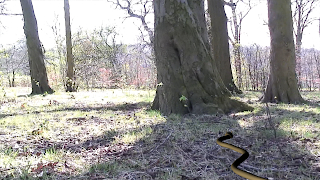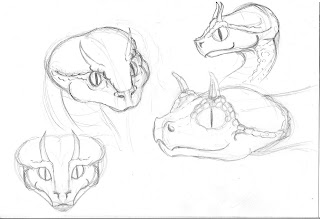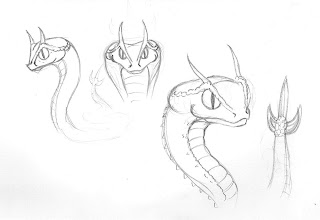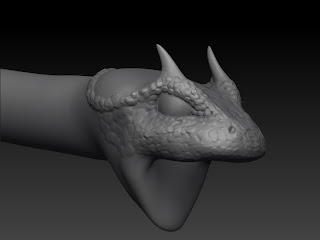As part of my Employability Pack I have been requested to create a brand for myself and include this on documents. Here is a business card design I put together using my logo and branding.
Front
I wanted to keep the front of the card as simple and clean as possible, with just my logo design. I chose this design as I feel it effectively simplifies my physical appearance into one element, which I think is important for making the business card memorable and unique, with a personal touch. I also incorporated a wireframe element into the logo to suggest the 3D element of my work.
Back (Details)
I went for a smarter look for the back, carrying through the grey element from the front and with a subtle repeat of the logo. I added a 3D rendition of my name while attempting to keep a balance between creative and professional.
I'm aware I probably refer to the front and back wrongly but I like to think that the design/identity element would be presented first, much like your face is the first thing presented to people in real life.
I am interested to see how these look printed professionally, so I will be ordering some through Vistaprint.
Welcome to the production diary of my Advanced Animation and Special Effects sequence.
Thursday, 12 May 2011
Friday, 6 May 2011
Sunday, 24 April 2011
Animation, Texture, Tracking Test
Here is an update of the snake in its current state. I feel this scene is nearing completion now. The end of the video is clearly not complete and the track becomes extremely unusable. These frames were meant to be omitted from the render but as a test I don't feel this is too important. I think the final shot will end with the snake facing/approaching the camera, so I may alter the timing on the animation to better fit within the areas of effective tracking.
Friday, 22 April 2011
Texturing - Diffuse Texture
Using the ambient occlusion as a guide, I painted a diffuse texture in Photoshop. I experimented with different ideas in order to find the look I wanted. Here are some of the different textures I created.
The final texture is the one I have chosen as I feel it is the most effective, it is nice and simple and fairly convincing as a snake texture. Here is the unwrapped texture painted in photoshop:
The final texture is the one I have chosen as I feel it is the most effective, it is nice and simple and fairly convincing as a snake texture. Here is the unwrapped texture painted in photoshop:
Thursday, 21 April 2011
Texturing - Projecting High poly onto Normal and Ambient Occlusion Maps
After unwrapping the snake model, I used render to texture to project the High Poly detail onto a normal map and also created an ambient occlusion map to add subtle depth to the diffuse texture when it has been created.
This is the low poly geometry with the normal map applied.
There are slight problems where the maps haven't baked properly however these will be painted out and less visible once the diffuse texture is applied.
This is the normal map generated through the render to texture process:
This is the ambient occlusion map created through the projection process, this will be used as a guide to paint the diffuse texture in photoshop.
With the ambient occlusion map applied, the model appears to have a little more depth in the face.
This is the low poly geometry with the normal map applied.
There are slight problems where the maps haven't baked properly however these will be painted out and less visible once the diffuse texture is applied.
This is the normal map generated through the render to texture process:
This is the ambient occlusion map created through the projection process, this will be used as a guide to paint the diffuse texture in photoshop.
With the ambient occlusion map applied, the model appears to have a little more depth in the face.
Tuesday, 22 March 2011
Shadow Catching
In order to realistically catch and create shadows I created a ground plane and a proxy tree with a Shadow/Matte material applied. This will allow me to use them both as a guide for the animation and to receive shadows and create realistic ambient shadows. I initially thought I would have to mask the tree out manually in post production, however after creating the spline and setting up the animation path around the tree I found the Shadow/Matte material does this automatically. The downside of this is that the tree model I am using will have to be built to match the tree in the footage exactly if the snake is to look like it is actually wrapping around the real tree.
The lights and shadows used in these screenshots are not those to be used in the final sequence, but clearly illustrate the effectiveness of the Matte/Shadow material.
Monday, 21 March 2011
High Resolution Snake
I have completed the high detail snake model, which will be used to project detail onto the lower poly version in the form of texture maps. Hopefully I can transfer enough of the scales detail to the ambient occlusion map to allow me to paint a diffuse map which is consistent with the scale pattern. However from my experience some of the high level detail is likely to be lost in the decimation process which is necessary in order to get the model stable in 3ds max.
Tracking footage
After capturing my desired shot several times, I tracked them using Syntheyes in order to see which would be the most effective.
After deciding on my shot, I exported the track script to 3DS Max and merged my rigged snake model. I set the image sequence of my chosen shot as the viewport background and used the tracking markers to position and scale the snake.

After deciding on my shot, I exported the track script to 3DS Max and merged my rigged snake model. I set the image sequence of my chosen shot as the viewport background and used the tracking markers to position and scale the snake.

I will now concentrate on replicating the floor plane and the tree in 3d in order to catch shadows and add realism to the scene. Modelling the tree will also prove useful as a guide for effectively animating the snake so it appears to be around the tree.
Thursday, 17 March 2011
Snake Animation Shot Test
I created a simple animation to test both my animation method and proposed shots for the footage.
At this stage I am happy with the results, however the snake looks very small and thin in comparison to the tree. If the snake was bigger I would need to use smaller bones and increase the amount to ensure the snake followed the path effectively without any extreme bends in the mesh.
At this stage I am happy with the results, however the snake looks very small and thin in comparison to the tree. If the snake was bigger I would need to use smaller bones and increase the amount to ensure the snake followed the path effectively without any extreme bends in the mesh.
Tuesday, 15 March 2011
Spline IK Animation Test
After playing around with the Spline IK method, I also found the progress along the path could be edited and animated to determine where the snake will be at set points in the sequence, which would prove very useful. Another benefit I have found with this method is that the actual vertices of the spline can be edited and animated, and no stretching will occur in the model's mesh, the path will simply be changed.
I created a simple test animation to see how effective this method of animation will be.
This has proven this method is probably the most effective for the results I intend to achieve. The only downside to this method is I am unsure how to rig the snake so I have control of the head. This is something I will look into.
Rigging with Bones
After testing the CAT rig I decided this was not the most practical method of rigging my snake.
I researched other methods and found I could rig the snake with basic bones and use a custom spline to drive the animation, almost like a train track. This sounded very appealing so I quickly created an IK bone chain to fit the snake, quickly skinned the snake to the bones and created a spline on which the bones would travel.
I will likely use this method for my final sequence, as it seems it will allow a larger level of customisation and control than keyframing, and any changes to the path will be visible instantly
I researched other methods and found I could rig the snake with basic bones and use a custom spline to drive the animation, almost like a train track. This sounded very appealing so I quickly created an IK bone chain to fit the snake, quickly skinned the snake to the bones and created a spline on which the bones would travel.
As you can see, by default the bones only affected the part of the mesh they were placed, suggesting the envelopes were too small and the bone count was not high enough. I experimented with editing envelopes and found that making the bones cover a greater portion of the model, the bends and coils became a lot smoother.
I will likely use this method for my final sequence, as it seems it will allow a larger level of customisation and control than keyframing, and any changes to the path will be visible instantly
Sunday, 13 March 2011
Snake Rigging Test
Before moving any further with my model I have decided to conduct a series of tests to determine the best way to rig and animate the low resolution model.
My preferred method of rigging would be through the use of the CAT system within 3DS Max. I created a custom rig preset and quickly skinned the model to gain some idea of how easy and effective the process would be. I then experimented with posing the snake to test the rig and skin.
The results of this test showed the bends looked square and too sharp. I was able to reduce this effect and improve most of the deformation by editing the skinning envelopes. Overall it looks a lot better but there are still some problem areas I was unable to fix.
While this may look a lot better, this is only a static pose and I have yet to test the way the rig animates. It's likely more bones will be needed to effectively recreate the fluid movement of a real snake. I also need to change the placement of the rig's 'neck' as it currently controls the front third of the snake and doesn't allow realistic movement or deformation of the head and affected body area.
My preferred method of rigging would be through the use of the CAT system within 3DS Max. I created a custom rig preset and quickly skinned the model to gain some idea of how easy and effective the process would be. I then experimented with posing the snake to test the rig and skin.
The results of this test showed the bends looked square and too sharp. I was able to reduce this effect and improve most of the deformation by editing the skinning envelopes. Overall it looks a lot better but there are still some problem areas I was unable to fix.
While this may look a lot better, this is only a static pose and I have yet to test the way the rig animates. It's likely more bones will be needed to effectively recreate the fluid movement of a real snake. I also need to change the placement of the rig's 'neck' as it currently controls the front third of the snake and doesn't allow realistic movement or deformation of the head and affected body area.
High Resolution Snake Work In Progress
Just an update to show high detail snake in its current state. Following feedback from my idea pitch I have decided to scrap the horror theme and instead I will focus on trying to create a nice, realistic animation of a new snake species. I intend to give the snake a camouflage ability so a lot of tests will be carried out to determine how possible this would be and how effectively it can be done.
I have refined the shape of the head to be more defined and look more like that of a horned viper. As the horror elements have been removed from my idea, the mouth will no longer need to be wide open and visible to the camera. I have made adjustments to the model so the mouth is closed, which has helped as before I had no way of seeing how well the bottom of the mouth lined up with the top.
There is still a little high frequency detail to be added and refined onto the head, and I intend to place a repeating scale pattern along the entire length of the body.
I have refined the shape of the head to be more defined and look more like that of a horned viper. As the horror elements have been removed from my idea, the mouth will no longer need to be wide open and visible to the camera. I have made adjustments to the model so the mouth is closed, which has helped as before I had no way of seeing how well the bottom of the mouth lined up with the top.
There is still a little high frequency detail to be added and refined onto the head, and I intend to place a repeating scale pattern along the entire length of the body.
Monday, 7 February 2011
Sunday, 6 February 2011
Research and Development into Industry Requirements
Compositing
I found a skillset outline for a compositing job, which effectively indicates how I can achieve a successful visual effects sequence while proving my suitability for employment.
“Compositors work in most areas of animation and post production.
They are responsible for constructing the final image by combining layers of previously created material. Although it is primarily a 2D role within the 3D world of CGI and VFX (Visual Effects), Compositors need a thorough understanding of the CG process combined with relevant artistic skills.
In post production companies, some TDs (Technical Directors) may do their own compositing.
What is the job?
Compositors work at the end of the production process. They receive material from various sources which could include rendered computer animation, special effects, graphics, 2D animation, live action, static background plates, etc.
Their job is to creatively combine all the elements into the final image, ensuring that the established style of the project is respected and continuity is maintained.
To achieve this they enhance the lighting, match blacks and other colour levels, add grain where required, add motion blur (if appropriate), create convincing shadows and make sure levels combine together seamlessly, keying (see glossary), rotoscoping and creating mattes where necessary.
They work closely with Lighters and need to have technical knowledge of how 3D lighting works in order to understand the 'multi passes' that the lighters create. They also liaise closely with Render Wranglers to progress work through the department.
Compositors need the talent to make artistic judgements, the technical skills to take practical decisions and the ability to analyse and solve problems.
Key Skills include:
- extensive knowledge of current compositing software such as Shake and After Effects;
- knowledge of various other programmes including Photoshop;
- understanding of 3D animation process, particularly Lighting;
- a good eye for composition, colour, light and shadow;
- good knowledge of keying process;
- methodical and thorough approach to work, and attention to detail;
- ability to communicate with colleagues and work as part of a team;
- ability to take direction and willingness to address comments and make changes;
- ability to work with a minimum of supervision;
- ability to deliver on schedule, working under pressure if required;
- respect for the procedures and requirements of a particular studio, production or pipeline;
- Knowledge of the requirements of the relevant Health and Safety legislation and procedures”
http://www.skillset.org/animation/careers/article_4926_1.asp
Show-reel Criteria
While searching for suitable showreel criteria I found a handy list of showreel tips on Double Negative Visual Effects' recruitment page (http://www.dneg.com/jobs).
While these are only the opinions of one visual effects company, they will prove very useful to consider when creating my own showreel to send to companies.
- Firstly, and most importantly, please ensure that your showreel is on a playable DVD video, not in quicktimes, and that it is working correctly. Print out your CV/resume and post this in with your reel and a breakdown sheet that highlights exactly what parts of the shots on the reel are yours. Just in case these get separated, make sure that your DVD also has your name and contact information on it - please add this in permanent marker, as a sticker can cause the DVD to jump.
- We only want to see the work that you're truly proud of. Ideally, the reel shouldn't be much longer 2 minutes for graduates and 3 minutes for experienced professionals (although this is only a guideline) and your best work should be at the start of the DVD. If you are a recent graduate, make sure that you put a snappy montage of your best bits of work on there, please don't just send in your final year project.
- Where possible, add in breakdowns and passes for your shots - ie. If you are a Modeller, add the topology to your render and if you have a compositing showreel, show roto mattes and before and after breakdowns so that we can see how you work. It can also be helpful in 3D to show your UV layouts, and also displacement maps as well.
- Don't spend too much time editing your reel to music - we watch most reels on mute as we're only interested in the images!
Justification of choices made
My desired job would involve 3D modelling and animation, so I have made this the focus of my visual effects sequence while still meeting the requirement of integrating digital elements with real world film. My aim is to make the model look and act as realistically and believably as possible and place this convincingly in my real world footage, which will require good modelling and animation skills as well as a good understanding of lighting and compositing techniques. When placed in my showreel I believe this sequence will show my suitability for employment in 3D Modelling, Animation and Visual Effects.
Research into proposed techniques
3D Elements
In order to create the 3D snake creature, there are several steps I will have to take.
Matchmoving
After capturing my footage, I will need to use matchmoving software such as syntheyes to create a digital representation of the camera. It is important to make sure the captured footage has enough standout elements to allow a good track. This will ensure any 3D elements I create will sync with the elements in the shot footage, making the 3D elements realistically appear as if they are in the scene.
Modelling and Texturing
First, I will model the snake to as high a quality as possible, to ensure it looks realistic. I will also have to texture the snake. As the snake will be fairly close to the camera in some points, it is important that I create the textures to a high enough resolution and quality that the illusion is not lost.
Rigging
After the model is complete and the textures have been created, I will need to create a custom rig to allow the snake creature to be animated. This will be done using the CAT system within 3DS Max as it will allow me to create a custom rig to suit the model very easily.
Animation
I will animate the snake creature using the custom rig I create, keyframing each bone to create realistic snake-like animation. It may be useful to create simple 3D representations of some elements such as trees to help convincingly animate sections where the creature will interact with these elements.
Lighting
It will be important that the 3D elements are lit in the same way as the live footage. For this reason I will have to be mindful of the lighting when capturing the footage, and attempt to convincingly recreate this within my 3D scene before rendering. It may also be useful to create simple 3D representations of some objects within the captured footage and set them to receive shadows only, such as trees. This will allow me to render the creature along with the shadows it would cast on the surrounding objects, creating a much more convincing illusion.
Compositing
To ensure the most streamlined integration of the 3D elements, I will render them in passes as image sequences with the alpha channels in place. This will allow me to combine the separate passes within after effects and overlay them onto the captured footage easily. After this, several steps will need to be taken to make the CG elements realistically appear to be in the scene.
Colour Correction
It is very likely that the 3D elements will stand out when placed in the live footage, so colour correction will need to be added to make the colour range of the 3D elements match that of the footage.
Masking
It will be important to mask off any elements of the original footage that the 3D elements would sit behind, in order to ensure the 3D elements appear to be in the scene.
Saturday, 5 February 2011
Creature Concept Sketches
After researching various types of snake and dinosaurs I created the following sketches to show how the snake creature in my sequence may look.


After creating some sketches I was happy with, I decided to attempt to create a 3D sketch in zbrush, concentrating mainly on the face. I am very happy with how this turned out and found it allowed a lot more freedom and experimentation than simple pencil and paper.


After creating some sketches I was happy with, I decided to attempt to create a 3D sketch in zbrush, concentrating mainly on the face. I am very happy with how this turned out and found it allowed a lot more freedom and experimentation than simple pencil and paper.

Idea Overview
I propose to create a visual effects sequence with 3d elements composited into real footage. I plan to model, texture, rig and animate a snake-like creature and convincingly integrate it into real life woodland footage. The sequence will be created with the idea that it will be a short scene in a thriller/horror movie based around the snake-like creature.
Visual Effects Blog
As part of my university course I will be creating a visual effects sequence.
I have created this blog as a means of documenting and annotating my tests, renders, prototypes and ideas as the piece progresses from concept to the finished sequence.
I have created this blog as a means of documenting and annotating my tests, renders, prototypes and ideas as the piece progresses from concept to the finished sequence.
Subscribe to:
Comments (Atom)





























